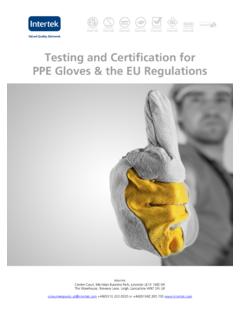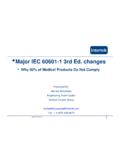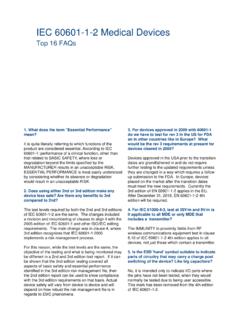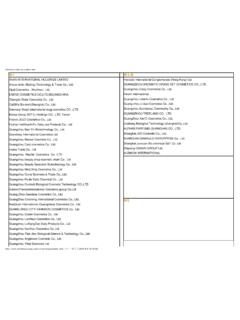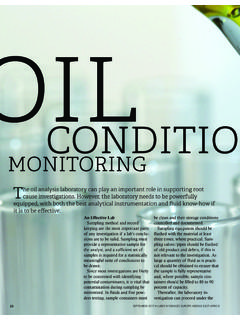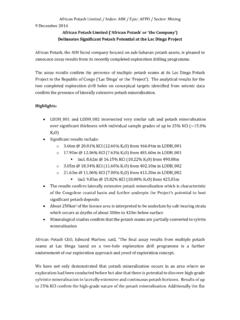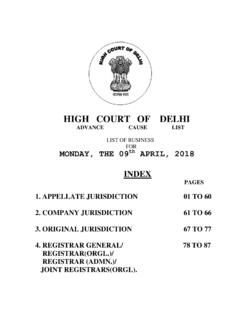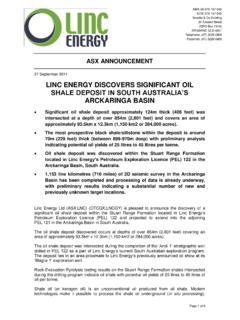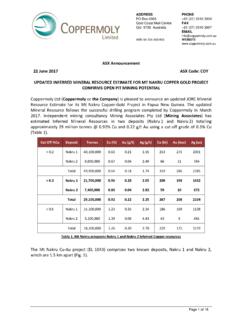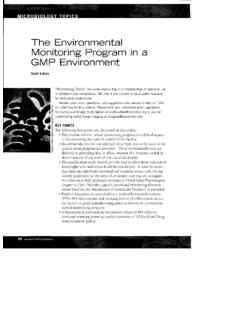Transcription of PQ Index - Intertek
1 Understanding the Lubricant Quality Scan (LQS) Analysis Report Viscosity Insolubles Flashpoint Water Content Acid Number Wear metal Elements PQ Index Particle count BN/Alkalinity Viscosity Lubricating oil is assigned the important task of ensuring that moving parts which interact within a machine system are provided with the required level of contact separation. It is not sufficient to say separation as some systems like the ring/liner interface in a combustion engine must interact to provide an appropriate gas tight seal even under dynamic conditions. However, in the main, lubricants are provided to reduce unwanted friction and to prevent destructive wear. Even finely machined metals have microscopically rough surfaces that when in contact will cause some wear which is considered normal. The lubricant minimises this wear by providing separation, cooling and surface protection.
2 Without which the systems would suffer from increased friction, heat and resultant damage such as local welding, scuffing, seizing and the unwanted transfer of metal debris. It is therefore critical that the lubricant have inherent physical properties to allow this to happen. The single most important characteristic of any lubricant used in conventional lubricated systems is its viscosity. In simple terms viscosity can be looked at as the resistance to flow. Syrup is highly viscous, has a high resistance to flow, whilst water has a very low viscosity and flows readily. In technical terms viscosity is expressed the rate of shear stress to shear rate and can be measured and reported in many different ways. Normally however it is expressed as a function of time. That is, How much per unit of time? A simple viscometer could be for instance a tin can (We ll call it CAN A) with a hole in.
3 Fill the can with the fluid to be tested and take out the cork. Measure the time it takes for the fluid to drain from one mark on the can to a lower mark. The number of seconds could be reported as x CAN A Seconds. This method could be used to compare different fluids or to see how a given fluids viscosity changes with use. The problem here however, is that viscosity changes with temperature so we would have to also measure the temperature at which the readings were taken and also derive some correlation between different temperatures. Nevertheless this is a useful and scientifically sound viscosity measurement tool or viscometer. Viscosity changes proportionally with changes in temperature, however the rate of change will be different for each fluid. To eliminate the need tomeasure every fluid at every temperature to predict behaviour, it has been found that the majority of mineral oil and synthetically produced oils have a viscosity that behaves in a predictable way, in that by knowing the viscosity at two temperatures we can either plot or calculate the viscosity at any other temperature.
4 Each fluid can be then given a unit less reference to allow us to do this. This is known as the Viscosity Index or VI. The higher the VI the less significant the change with change in temperature and inversely, the lower the VI the greater the degree of change. Viscosity Index itself is a dimensionless number derived using ASTM D2270 which relates the subject lubricant s values for viscosity at 40 C and 100 C to two hypothetical oils with Viscosity indices of 0 and 100 respectively. Normally for most modern mineral refined lubricants which do not contain VI enhancing additives, the VI will be in the region of Ca. 95, however with additive enhancement this can rise to 150 or as high as 250 for highly specialised oils. Furthermore modern synthetic lubricants can be designed with a very high VI, however these tend to be only used for highly specialised applications, as the cost to manufacture prohibits their wider value.
5 Using the correct oil with the right viscosity is critically important for good machine operation as this will ensure that the mechanical operation of the systems and its components relative to one another remains within the intended design scope. Used lubricating oils may show an increase of viscosity due to oxidation/nitration or as a result of contamination with unburnt fuel components within diesel engine oil. Dilution with high viscosity fuel oil or the by the addition of another lubricant with a higher viscosity grade are two other possible causes. By comparing test results for viscosity with the original equipment manufacturers (OEM s) requirements and the new oil, we can monitor this and thus react should any unexpected variation occur. The accepted limit for change is generally, but not always 15% of the new oil value at 40 C.
6 In conjunction with evidence of oxidation, knowledge of contamination by fuel and water obtained from our extensive test suite the viscosity provides useful and significant information to allow you to manage reliable operation. The LQS analysis process first considers the grade in use in comparison with the stated grade to look at material deviance from an intended standard then looks at the implication of the value in respect of the good operation of the machine, as having an oil with a viscosity different to that stated does not necessarily mean that the equipment will operate at a higher risk of failure. It is clearly beneficial however to not only state the actual grade in use on the sample bottle, but also to check that the grade in use is what has been recommended by the OEM as amended following a rationalisation exercise by the lubricant is worthy of note to state that successive grade list rationalisations which may have been carried out following further changes in oil suppliers, may result in the use of lubricants of which their specifications are not now ideal.
7 It is suggested that the current oil supplier makes a statement to the effect that the lubricants recommended in the lubrication survey are suitable for use in the stated machinery and not that they are equivalent to the oils supplied by the previous oil supplier. Insolubles During its service a lubricant is subjected to a wide range of environmental variations which lead to either the production or inclusion of contaminants. Such contaminants require the parent fluid to have additional inherent protective qualities however, even with the best protected oils the presence of these materials can degrade the base oil and additive system producing insoluble particulates which can be indicative of embedded root cause and be detrimental due to their abrasive qualities. Such contaminants can include Heat Entrained air Incompatible gasses Moisture Internal and externally generated contaminants Partially burned fuel compounds Other oils etc.
8 Regular monitoring for the presence of insolubles provides an useful indication of the operating condition of any oil system but is especially useful for engines. In addition this test is regularly used to measure the effectiveness of engine system filters/centrifuges/purifiers etc. providing an effective tool in safeguards against costly breakdowns, as it is recognised that any increases in the presence of insolubles indicates a malfunction. Flashpoint The property known as flashpoint is the lowest temperature at which a vapour produced by the liquid will ignite when a flame is applied under standard conditions. The oil is said to have flashed when a flame appears and instantaneously propagates itself over the entire surface. Below a certain value there is a high risk of very serious incidents in service, including crankcase explosions.
9 Because of the low flashpoint of most fuels, a sudden drop in flash temperature within crankcase oil can usually be relied upon as an indication of dilution. Therefore the flashpoint must be monitored very carefully. Originally when the test was first standardised back in 1924, the flashpoint was developed for the purpose of determining the fire hazard of fuels and oilsbeing stored or transported. By examining engine oils the flashpoint can determine whether the fuel has been contaminated by distillate fuel. This isn t an exact science as the contaminant residual fuel may not appreciably depress the flash point, only if its flashpoint is naturally low. Generally flashpoints of oil are expected to be in excess of 200 C, however when a flashpoint is depressed to <180 C then we would advise remedial action.
10 This can sometimes be achieved full replacement charge, however when significantly low a renewal of charge will be recommended. Water Content Water contamination can occur from various sources in new or used oils. Storage tanks can encourage water condensation simply from ambient air changes, with the result that free water can collect at the bottom of storage tanks over many years failure to remove this water will, in time lead to water being drawn into the operational system with potentially catastrophic results. In addition free water can be generated, for instance in Air compressors due to the water vapour present in air condensing under unfavourable operating conditions. In diesel engines water vapour is produced during combustion which can condense within the crankcase and mix with the oil. Stern tubes experience water ingress due to damaged seals and wear within the shaft bushing which can allow water into the system.




